Postero medial disk herniation
Leaning towards the side of pain
Postero medial disk herniation when the sign of Pisa leans towards the pain.
Pisa sign
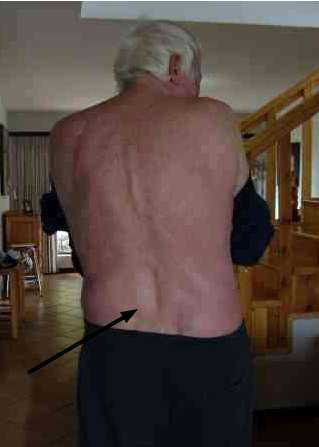
LEFT lower back pain
The medial disc is an enigma; it's easier to treat with chiropractic adjustments, and it responds much faster than its cousin the lateral disc, but it still takes 6 to 8 weeks to heal.
More medial
discs end up in surgery because the pain often goes away after a few
treatments, so the patient resumes normal living, bending and sitting
before the disc has healed; and perhaps ignoring the rehabilitation program. So,
it happens again; and yet once more. And then ultimately the patient goes under the
knife when the leg pain becomes severe. That won't be you, though.
Notice here that our friend is leaning to the left; towards the side of pain. Easy come, easy go is the name of the game with medical discs. Or, more to the point, easy go, and comes right back with a vengeance.
The pain may be gone in a few days, but it still takes at least 6 weeks with chiropractic treatment for the disc to heal, and perhaps longer if you've had the pain for some time. The disc has a poor blood supply and healing is only complete several weeks after the pain has abated. It's vital that you follow our slipped disc rules if you want to escape the knife.
The antalgic list, also known as a functional scoliosis, meaning it's temporary, is a very serious sign. Both standing and sitting are painful, and walking often nigh impossible.
Controversially, massaging bed rest is in my opinion the only option. It's not back by research which indicates that bed rest is not the solution to back pain.
Notice how the bulge in the picture below is in the so called armpit, medial to the nerve. Now our friend gets relief by leaning towards the painful side; to the left.
In short, with a postero medial disk herniation you get relief by leaning towards the side of pain.
Remember, not all disc bulges go into an antalgic posture; it is in my book however, a very serious sign, often the prelude to radiating pain down the leg if those slipped disc rules are not taken seriously.
You'll soon notice that I'm not advocating just bed rest for a slipped disc. It's bed rest, plus exercise and ice once the disc has been reduced with chiropractic manipulation.
The lower discs affect the sciatic nerve and it's not difficult to test if the nerve is pinched; you can do it yourself using the slump test.
The higher lumbar discs affect the femoral nerve and that's more difficult to test for.
Antalgia
An antalgia, leaning towards the side of pain, is characteristic of the postero medial disk herniation.
Take this antalgic posture seriously; it's often the prelude to a serious sciatica.
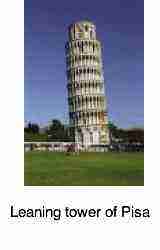
- Front of the leg: Femoral nerve ...
- Back of leg: Help for Sciatica pain ...
- Slipped disc rules
- Massaging bed rest
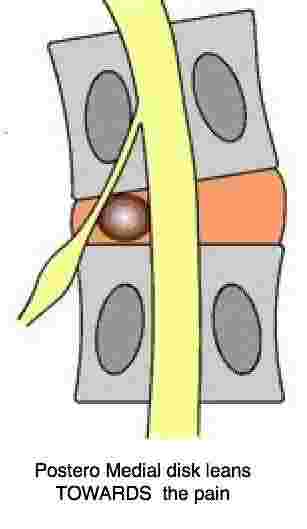
Slump Test
Sitting, in an ordinary chair, straighten your leg on the painful side parallel to the ground. It probably hurts, in the back, and perhaps in the same leg. This is the first phase of the Slump test for sciatica...
Now straighten the opposite leg. With the Postero Medial Disk Herniation, straightening the opposite leg often, though not always, hurts even more - on the opposite side. Usually in the back on the opposite side of the back. If it hurts in your opposite leg, then it is considerably more complicated. You will need to go to bed, and be patient. This isn't going to get better quickly.
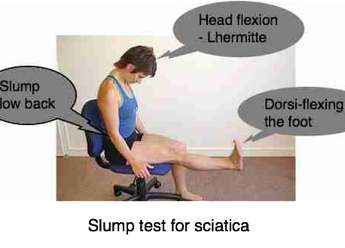
Bizarre
One of the characteristics of the Postero medial disk herniation is that it sometimes may flip-flop. One day you are leaning towards the painful side. The next day away from the painful side. It's what makes this type more difficult to manage. Your chiropractor will have to be on his/her toes. And so will you.
Home treatment
Different doctors will have different opinions, but my advice with regard to the postero medial disk herniation is:
- Go to bed until you can stand up straight. It's usually a few days, depending on how long you've been looking like the leaning tower of Pisa; it's known in medical jargon as an antalgia. Not continous bed rest; that's not advocated in my book.
- Do some specific exercises that your chiropractor will prescribe for you. Do them every hour, and more often if you want.
- Ice your back twice a day or more often; it's the best
painkiller too. Follow the cold with a little warm, moist heat; a shower or a hot
water bottle. Don't get in the bath.
- Every hour roughly, though there's nothing magical about 60 minutes, shall we rather say regularly, get up and walk around. Go to the toilet, make a sandwich, perch on the edge of a desk for a bit, but don't sit. When your back starts talking to you, go and lie down again.
- Please try very hard not to cough or sneeze. Blowing your nose will often stop a sneeze but you must be quick; don't delay.
- Follow your chiropractor's instructions to the letter. This is a serious condition. Research shows that a higher percentage of patients with medial discs end up in surgery. I believe that is simply because patients, and sometimes their doctors too, aren't prepared to, or don't understand that they must wait out the six weeks before playing silly buggers again.
- Follow
your chiropractor's rehab program earnestly. Please, take it seriously;
then everyone ends up happy. Except the surgeon; he's just lost out on
his annual ski holiday. Seriously, I'm not knocking good surgery, I
refer patients to good neurosurgeons on occasion.
- Don't sit for several days, and then as little as possible until you are much better. Sitting dramatically increases the pressure in the disc. Let me say it again. Don't sit initially, and then for graded periods only.
- Do not bend over if you have to pick something up off the floor. Go down on one knee; again, one knee and not both. Don't squat and absolutely don't bend and twist simultaneously.
- Smoking. Every day is a good time to
quit, but it's vital now. Research shows it's the most important factor
as to whether your back heals properly, or not. At least cut back hard
for a few weeks. Better still Stop Smoking Permanently ...
- Some new research shows that Lumbar belts or corset help patients with low back pain in regards to pain and function. Wear a belt for a week or two, especially if you simply have to go back to work. Try not to wear it all day. Lie down periodically during the day for five minutes and do the exercises.
- Say your prayers and take your postero medial disk herniation seriously. The pain will probably go away quite quickly, but remember it comes back quickly too if you aren't sensible. Believe me, I've been a chiropractor for over thirty years.
Daily Exercise Routine DER
Absolutely nothing is more important that a DER if you suffer from chronic back pain. You will be able to identify here with Matt's struggle with his back. How construction work was the cause, but office work and long hours driving made it even worse. Read more about his daily exercise routine.
- Use the alternating cold hot therapy too.
From the coal face
Anecdotes on health care abound, and let's be quite clear: scientifically they have no value whatsoever. Having said this, you may find this anecdote on a severe Postero-Medial slipped disc interesting. This man had severe leg pain with a compromised motor nerve preventing him from raising his heel from the ground. Click here and scroll down to 18-03-2009 … SHORT ANECDOTE
- More LOWER BACK EXERCISES ... on YouTube, scroll down to Lumbar disc syndrome exercises.
50 percent less pain
Once your chiropractor has reduced the postero medial disk herniation you will stand upright and there will be a dramatic relief of pain. But it WILL take 6 weeks to heal, perhaps longer, even though the pain may be gone in a week or two; beware especially when you have 50 percent less pain.
Do yourself a favour and go through the full rehab program,
otherwise the chances are good that you'll be looking like Pisa again
within a few months.
50 PERCENT LESS PAIN ... the dangerous time.
GARDENING
The worst thing for the low back is the chair. Exercise is what will improve your spinal health. But heavy sports like squash and tennis, and gardening require that you follow the rules religiously. Lower back exercises every morning before getting out of bed, do a warm up and cool down program assiduously before sport and gardening
I used to suffer myself occasionally from a lumbar disc protrusion at L5 S1, but my back has gone from strength to strength since I have started heavy gardening in my semi retirement. But then I have a chiropractor in the house, my daughter, who cares for me periodically. I do my lower back exercises very faithfully, and have a treatment from her every six weeks. It's a good formula; it works.
So, what the real cost of low back pain in society? It has become the most expensive item in many Western
countries' health budget. It could become your most expensive item. Take
the first attack seriously, don't assume it happens only to other
people and get started on your own daily exercise routine.
In fact, I promote back exercises, like brushing teeth, for everybody, whether you've had a back problem or not. After all 80 percent of people are going to suffer these potentially crippling attacks of lower back pain periodically; these exercises take less than two minutes. Do them before getting out of bed every morning.
In fact, once you're in the groove, you can do them whilst still in that indulgent period between sleeping and waking. Wake up slowly and whilst saying your prayers or planning the day your body can go through the first moments of preparation for that busy day.
Are you leaning away from the pain? The second common disc injury is called the postero lateral herniation, and you lean in the opposite direction; away from the pain. It needs to be managed quite differently but both demand a life long commitment to a daily exercise programme; or, suffer from chronic disabling lower back pain.
- Leaning AWAY FROM the pain? The Postero LATERAL disk herniation ...
- Lumbar disc protrusion
- Lower back pain ... the real cost.
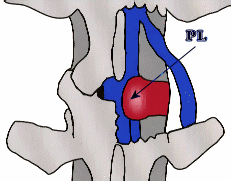
Postero medial disk herniation
I'm under no illusions about the difficulty of stopping smoking, but neither shouldn't you be; it really is the most significant factor as to whether all forms of treatment for your lower back and leg pain will succeed or not.
Useful links @ POSTERO MEDIAL DISK HERNIATION
Lower back and leg pain
The seriousness of lower back and leg pain is of course that it can pinch the Femoral Nerve ... the nerve that supplies in the main the groin and front of the leg, or the sciatic nerve which innervates mainly the back of the leg and foot.
The
Femoral nerve test is difficult but you can test yourself for sciatica
at home...
SLUMP TEST for sciatica
Slipped disc nutrition
Slipped disc nutrition is a vital part of making sure this doesn't occur repeatedly. Also capsaicin health benefits will help reduce pain and inflammation; eat more jalapenos.
Have A Question about your lower back?
I receive many questions about Chiropractic. It might be help with a spinal condition, but it might also be from a person who can't walk after a hip operation, or some such thing.
I will do that by answering your questions personally, but it will be converted to a Web Page so others can benefit from your questions. Omit your name if you like.
However, do understand that, in the main, I'm going to be directing you, should it be pertinent, to a Chiropractor in your neck of the woods. I'll respond to all reasonable inquiries, but please be specific, and give as much detail as you can.
Do understand that lower back pain is extremely complex, so I can only give general guidelines. There's no substitute for a careful thorough chiropractic examination.
What Other Visitors Have Said
Click below to see contributions from other visitors.
If you find my answer useful, please ask friends to grade it.
HDL L5-S1 with sciatica on right foot 




Home > Postero medial disk herniation > HDL L5-S1 with sciatica on right foot
Hello, My name is Daniel, i am 30 years old, …
Pisa sign and sciatica with disc protusions at levels L4-L5 and L5-S1 




Pisa sign and sciatica with disc protusions at levels L4-L5 and L5-S1 is going to be difficult and my book needs intermittent bed rest.
Hi there, …
Leaning to the left without any pain 




Leaning to the left without any pain.
Thank you very much for your wonderful article on the Pias Sign. I have been to my GP who is known for his skill …
very bad back pain going down left leg waist swelling. Not rated yet
Chiropractic Help homepage »
Postero medial disk herniation
» Very bad back pain going down left leg waist swelling
Every so often …
Lower back pain Not rated yet
Hi. I have had lower back pain for at least 5 years now. The first time I really noticed it was a night after I had been breaking limbs for the fireplace …
L4 and L5 sciatica left leg Not rated yet
My problem originated from lifting heavy boxes on 30 May 2013 which was further exacerbated by moving warehouse 21 days later, on the 21 June 2013. After …
limping Not rated yet
From all that I have read, I must have a pinched nerve. I have a limp that has been getting worse over the last 5 years. I fill like i'm dragging my leg. …
Did you find this page useful? Then perhaps forward it to a suffering friend. Better still, Tweet or Face Book it.
